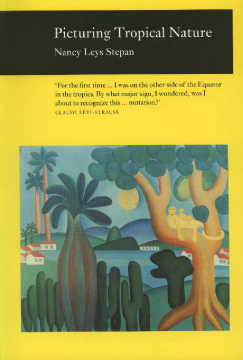
Additional Information
Book Details
Abstract
Whether considered a sublime landscape, malignant wilderness, or the endangered site of environmental conflicts, the tropics are, Picturing Tropical Nature argues, largely a construct of American and European imaginations.
Nancy Leys Stephan asserts that images of the tropics conveyed through drawings, paintings, photographs, literature, and travel writings are central to what Stepan calls the “tropicalization of nature,” or the often harmful misrepresentation of the tropics and its peoples. She here examines several aspects of such tropicalization as they emerge through the work of nineteenth- and twentieth-century scientists and artists, including Alexander von Humboldt, Alfred Russel Wallace, Louis Agassiz, Sir Patrick Manson, and Margaret Mee. From the earliest photographic attempts to represent tropical hybrid races to depictions of disease in new tropical medicines, Picturing Tropical Nature offers new insight into the convergence of the tropics with European and American science and art.
“A brilliant and provocative book . . . the kind of book that carries forward a field in a single stride . . . undoubtedly the finest account of ‘tropicality’ we have.”—Social History of Medicine
‘[a] brilliant and provocative book . . . The kind of book that carries forward a field in a single stride. It is both an insightful account of tropicality and a cultural history of Brazil, in which environment, race, disease and aesthetics constantly and uncomfortably intersect
. . . [Stepan] moves freely from broad trends in the representation of the tropics to the more intimate imaginings of the "representative figures" around whom her narrative is constructed. This is undoubtedly the finest account of "tropicality" we have.’ – Social History of Medicine
'A fascinating examination of how the tropics have come to be represented since the eighteenth century, drawing mostly on a marvelous array of materials from Brazil . . . Some of the images she brings to light are truly gruesome, but she uses them well to demonstrate how the tropics became "a place of peculiarity" – and how indelible many of these perceptions remain.' – Foreign Affairs
'In Picturing Tropical Nature, Nancy Leys Stepan offers a beautiful and fascinating portrait of a subject many people have rarely taken the time to consider.' – Virginia Quarterly Review
'In this lucid and well-researched [book], Nancy Leys Stepan, an expert on both Latin America and the history of race . . . [analyzes] the range of visual practices through which South American nature was represented in the nineteenth and early twentieth centuries. Organizing her study around depictions of tropical nature, diseases, and races, Stepan convincingly argues that the entire Victorian understanding of the tropical was profoundly shaped by sophisticated visual strategies and genres, and that South America, more than any other region, functioned as the site of tropical nature par excellence.'
– Victorian Studies
'Nancy Leys Stepan, whose books on race and eugenics have been rightly acclaimed, has now moved into the field of analysis of illustrations to add to this growing literature on the tropics . . . Stepan marshals some intriguing material, and it is all handled with verve and style. The sections on medicine and medical photography are particularly acute.' – American Historical Review
'Important historical scholarship offers insights by examining underdeveloped subjects, periods, or areas; by demonstrating new methodological approaches; or by drawing connections between seemingly disparate fields and disciplines. Picturing Tropical Nature, by Nancy Leys Stepan, succeeds on each of these levels. With images of the South American tropics as her focal point, Stepan demonstrates the significance of this neglected region and several largely ignored scientists, while locating the common ground between environmental history, history of science, and history of medicine . . . breaks new ground in revealing the significance of images in the analysis of scientific, medical, and cultural beliefs regarding tropical spaces, peoples, and diseases. One can only hope that others will follow Stepan’s lead and begin to explore the fertile territory of imagery in the tropics.' Journal of the History of Biology
'In this beautifully illustrated and fascinating book by Nancy Stepan, images of the tropics have had everything to do with how we have perceived the lands between the Tropics of Cancer and Capricorn . . . an important and innovative work that helps us rethink and reimagine the American tropics.' – The Americas
'Not only environmental art history but also philosophy and ethics enter into Picturing Tropical Nature as the author deftly steers her course through a selection of nineteenth century exploration illustrations, the racial photographs of “Agassizian” science and an exposition of the concept of tropical disease. It is a challenging agenda which addresses current issues of environmental concern ranging from wilderness preservation and biological imperialism to aboriginal rights and identities.' – Environmental History
Nancy Leys Stepan is professor of history at Columbia University. Her previous books include “The Hour of Eugenics”: Race, Gender, and Nation in Latin America.
